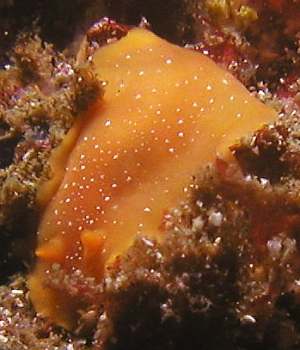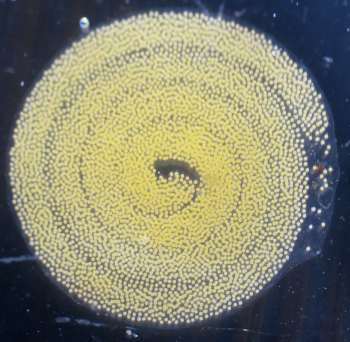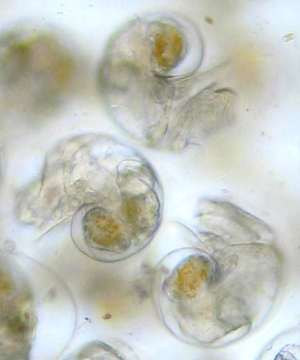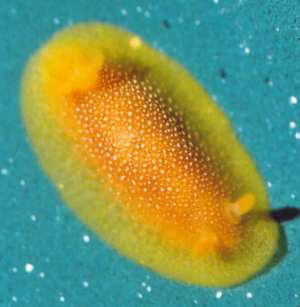
Doriopsilla gemela
Gosliner, Schaefer & Millen, 1999
Order: NUDIBRANCHIA
Suborder: DORIDINA
Superfamily: EUDORIDOIDEA
Family: Dendrodorididae
DISTRIBUTION
Gulf of California, Mexico to Monterey County, California, USA.
PHOTO
Shag Rock, Santa Barbara Island, California, USA. July 19, 2003. Photo: Chris Grossman.
Doriopsilla gemela is similar in colour to D. albopunctata with small opaque white spots, but the mantle of D. gemela appears much smoother although it has some minute tubercles. It grows to 40 mm. Its rhinophores are yellow-orange to yellow and they have 7-10 lamellae. There are 5-7 bright orange or yellow bi- to tripinnate gills. The egg ribbon forms a flattened spiral of 3 whorls, and the larvae are lecithotrophic. It differs from D. albopunctata in having deep yellow or yellow-orange gills whereas D. albopunctata has white or pale yellow gills. There are fewer rhinophore lamellae in D. gemela, and the larger mantle tubercles of D. albopunctata contain glands while the small ones of D. gemela don't. The larval development type and egg ribbons are also quite different.
Baptodoris mimetica Gosliner, 1991 is also very similarly coloured. D. albopunctata differs in having a relatively soft & fleshy body while B. mimetica is more rigid and the mantle is covered with microscopic caryophyllidia. The gills of B. mimetica are held more erect, and unlike species of Dendrodoris and Doriopsilla, Baptodoris mimetica has a head and oral tents. There are of course many anatomical differences.
Despite these many apparent differences, it is not always easy to distinguish these three species from photographs.
References:
• Gosliner, T.M. (1991) Four new species and a new genus of opisthobranch gastropods from the Pacific coast of North America. The Veliger, 34(3): 272-290.
• Gosliner, T. M., Maria C. Schaefer, & Sandra V. Millen. (1999) A new species of Doriopsilla (Nudibranchia: Dendrodorididae) from the Pacific Coast of North America, including a comparison with Doriopsilla albopunctata (Cooper, 1863). The Veliger, 42(3): 201-210.
Rudman, W.B., 2003 (July 29) Doriopsilla gemela Gosliner, Schaefer & Millen, 1999 . [In] Sea Slug Forum. Australian Museum, Sydney. Available from http://www.seaslugforum.net/find/dorigeme
Related messages
Larval development in Doriopsilla gemela
November 23, 2005
From: Jeff Goddard

Hi Bill,
Here are some photos of Doriopsilla gemela from San Diego, California showing: (1) the color of the gills, (2) its flat egg mass, and (3) a hatching larva. The larvae I observed developed from eggs averaging 111 microns in diameter and hatched after 8.5 days (at 15-21 degrees C) with shells 173-184 microns long. They lacked both propodium and eyespots and were clearly planktotrophic.
Locality: Point Loma, San Diego, California, USA. Pacific coast. Intertidal. Length: 16 mm. 27 April 2005. Rocky intertidal. Photographer: Jeff Goddard
As I discussed in my recent review of developmental mode in the family Dendrodorididae, the report by Gosliner et al (1999) of lecithotrophic development in this species requires confirmation because (1) they did not describe the hatching larvae or give any measurements of its size, and (2) the eggs in their Figure 4B appear to measure about 100 microns in diameter, not the 240 microns stated in the text. Jim Lance (personal communication, 2005) has also noted planktotrophic development in D. gemela collected from San Diego. In a further twist, Jim has also observed direct development in a yellow-gill porostome from Bahia de Los Angeles in the Gulf of California. According to Gosliner et al. (1999), this latter form is also D. gemela. However, given the rarity of variable mode of development, or poecilogony, I suspect the form from Bahia de Los Angeles is actually a cryptic species. More work clearly remains on this taxon.
-
Gosliner, T.M., M.C. Schaefer, and S.V. Millen. 1999. A new species of Doriopsilla (Nudibranchia: Dendrodorididae) from the Pacific coast of North America, including a comparison with Doriopsilla albopunctata (Cooper, 1863). The Veliger, 42:201-210.
-
Goddard, J.H.R. 2005. Ametamorphic direct development in Dendrodoris behrensi (Nudibranchia: Dendrodorididae), with a review of developmental mode in the family. Proceedings of the California Academy of Sciences, 56: 201-211.
Best wishes,
Jeff
goddard@lifesci.ucsb.edu


Dear Jeff,
Thanks for these interesting observations. It would be interesting to know why some species lay flat egg masses like this, rather than the more 'normal' way with one edge attached to the substrate. It is apparently not restricted to one phylogenetic group as we know of many chromodorids that do it also [see Fact Sheet].
Best wishes,
Bill Rudman
Doriopsilla gemela from California
July 31, 2003
From: Chris Grossman

Dear Bill
This picture was taken near Shag Rock, Santa Barbara Island, California on July 19, 2003.
It is described in Pacific Coast Nudibranchs by David W. Behrens as Dendrodoris sp. 1.
Chris Grossman
seaslugforum.net@diver.net
Grossman, C., 2003 (Jul 31) Doriopsilla gemela from California. [Message in] Sea Slug Forum. Australian Museum, Sydney. Available from http://www.seaslugforum.net/find/10585Dear Chris,
I guess this is Behrens' 'Dendrodoris sp. 1' which has been named Doriopsilla gemela by Gosliner, Schaefer & Millen (1999}. However I can't see the colour of the gills which should be yellow or orange if it is D. gemela.
D. gemela is very similar in colour to D. albopunctata with small opaque white spots, but the mantle appears smoother, although it has some minute tubercles. It grows to 40 mm and differs from D. albopunctata in having deep yellow or yellow-orange gills rather than the white of D. albopunctata. Another major difference is the shape of the egg ribbon and the type of larval development. The egg ribbon forms a flattened spiral of 3 whorls, and the larvae are lecithotrophic [planktonic, free-swimming but non-feeding]. The egg ribbon of D. albopunctata by comparison is a spiral attached along one edge. The larvae are planktotrophic [planktonic, free-swimming but feeding]. This again shows the value of photographing and recording egg ribbons if their parent can be confidently identified, because they can often give us clues to the presence of more than one species in a group of very similar looking animals.
• Gosliner, T. M., Maria C. Schaefer, & Sandra V. Millen. (1999) A new species of Doriopsilla (Nudibranchia: Dendrodorididae) from the Pacific Coast of North America, including a comparison with Doriopsilla albopunctata (Cooper, 1863). The Veliger, 42(3): 201-210.
Best wishes,
Bill Rudman
